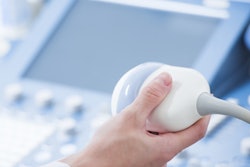
Some 15 years after the first ultrasound contrast agents were cleared in the U.S., the technology remains underutilized. It's now time to consider another path toward broader acceptance, according to a Thursday talk at the International Contrast Ultrasound Society (ICUS) Bubble Conference in Chicago.
Advocates for broader ultrasound contrast use in the U.S. are seeing opportunities in a recent defeat handed to the U.S. Food and Drug Administration (FDA) over what kinds of off-label statements vendors can make to physicians about their products.
The FDA legal defeat, coupled with the pursuit of temporary CPT codes for new ultrasound contrast indications, could be used as a stepping-stone to move beyond the current FDA-cleared indications in echocardiography to applications such as liver imaging, according to Dr. Michael Main, medical director of the Echocardiography Laboratory at Saint Luke's Mid America Heart Institute in Kansas City.
Legal setback for the FDA
Last month, the FDA lost a legal challenge by pharmaceutical firm Amarin involving FDA regulations that prohibit pharmaceutical companies from making truthful off-label statements to physicians, Main said. Amarin manufactures Vascepa, which was approved by the FDA for treating patients with very high triglyceride levels.
Amarin had been seeking a broader indication for the drug and thought it could do so as a supplemental indication. But the FDA didn't believe the company had adequate clinical data to support the new use and charged the company with misbranding its product.
The case ended up before a federal judge in New York, who on August 7 ruled in favor of Amarin, stating that the FDA can't prosecute pharmaceutical companies for speech that promotes the lawful off-label use of an FDA-approved drug. The FDA chose not to appeal.
The judge in the case noted that off-label use is the norm in the U.S. rather than the exception, Main said.
"He also went on to say that the 'therapeutic -- indeed sometimes even lifesaving -- value of off-label uses of FDA-approved drugs has been widely recognized,' " he said.
Now that the FDA has been dealt a serious setback in federal court, the question is whether ultrasound contrast developers will take a more aggressive stance in marketing off-label indications for their products, according to Main.
"We will see," he said.
FDA and ultrasound contrast
Although it has been modified since it was initially mandated by the FDA in 2007, the black box safety warning still remains in place for ultrasound contrast agents.
"There are continued product label 'warnings' against the use of ultrasound contrast agents in sick patients -- the ones who derive the greatest benefit -- and there is a continued shunt contraindication," Main said.
In addition, the FDA hasn't cleared any new ultrasound contrast indications in more than 15 years, despite the successful completion of two large stress perfusion trials and the demonstrated efficacy of ultrasound contrast in many other disease states as well.
"The question I would ask is: Is it time to pursue another path?" he said.
Once a drug or device is approved, it's acceptable for physicians to use it off-label, he noted. The FDA also doesn't determine which services are reimbursed; procedural codes, relative values, and ultimately reimbursement are determined through a process governed by the American Medical Association (AMA) and the U.S. Centers for Medicare and Medicaid Services (CMS), and also separately by private carriers.
CPT add-on codes
A recent initiative to implement a new CPT add-on code for myocardial strain imaging could serve as a template to get reimbursement for new ultrasound contrast indications, Main said.
A code change proposal (CCP) for myocardial strain imaging was submitted last year to the AMA CPT panel and was presented at the February 2015 CPT meeting, he said. That led to the establishment of a category III add-on code (+0399T) for imaging myocardial strain to assess myocardial deformation. Published on July 1, the code will be active on January 1, 2016.
Category III codes are temporary CPT codes issued for emerging technology and are not reimbursed by CMS. However, they may be reimbursed by private payors, Main said.
There's also an opportunity for category III codes to progress to category I status (reimbursable by CMS) in one to two years, provided that the code has demonstrated significant utilization and additional peer-reviewed literature substantiates clinical utility.
Myocardial perfusion imaging
Following that strategy, an add-on CPT code is in the works for myocardial perfusion imaging. In July, the American Society of Echocardiography (ASE) submitted a code change proposal that describes myocardial contrast perfusion echocardiography at rest or with stress for assessing myocardial ischemia or viability, Main said.
If approved, that add-on CPT code could potentially be reportable along with CPT codes 93306, 93307, 93308, 93350, and 93351, he said. If category III status is conferred by the CPT panel in October, the code will be published on January 1, 2016, and go live on July 1, 2016.
"Of course, there would be opportunities then to pursue reimbursement from private carriers and local Medicare contractors, and also, importantly, to track utilization of this service, which at the current time we really just can't do," Main said.
In response to an audience question, Main said he would "absolutely" suggest that this pathway be used to pursue liver imaging applications for contrast-enhanced ultrasound.
"Some people kind of discount the value of an emerging technology code, but it is a marker and gets you on the map," he said. "It allows you to track currently for all of these services. Right now, nobody really knows how frequently they are being performed."
The end of the beginning
Market research firm Arlington Medical Resources projected in June that contrast echocardiography will make up 4.5% of total echocardiography studies in 2015, up from 2.5% in 2005 and from less than 1% in 2008, after the FDA mandated the black box warning, according to Main.
"Utilization continues to climb, although I think it remains far short of all of our targets," he said.
With respect to finally reaching targets for contrast-enhanced ultrasound, Main cited British Prime Minister Winston Churchill's famous 1942 quote after the defeat of the Axis armies in North Africa during World War II.
"Now is not the end," he said. "It is not even the beginning of the end. But it is, perhaps, the end of the beginning."




















